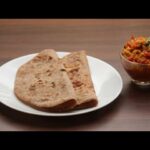
Khapli Wheat Flour Mix Vegetable Paratha
- Author: Mubarra
- Prep Time: 20 minutes
- Cook Time: 10 minutes
- Total Time: 30 minutes
- Yield: 1 portion
- Category: main course, bread
- Method: stovetop cooking
- Cuisine: Indian
- Diet: Vegetarian
Description
Introduction
Khapli wheat, also known as emmer wheat or farro, is an ancient grain that has recently gained popularity due to its numerous health benefits. Unlike modern wheat, Khapli wheat is less processed and retains more of its natural nutrients. It is rich in fiber, protein, and essential minerals like magnesium and iron. This makes it beneficial for digestion, muscle function, and overall health. Khapli wheat has a lower glycemic index compared to regular wheat, making it suitable for people with diabetes or those managing their blood sugar levels. Its dense nutritional profile and lower gluten content also make it a great option for those looking to improve their diet quality.
Benefits:
- Rich Nutritional Profile: Khapli wheat is renowned for its dense nutritional composition. It is a good source of dietary fiber, protein, vitamins, and minerals, including iron, magnesium, and zinc (Sharma et al., 2016).
- Improved Digestive Health: The high fiber content in Khapli wheat promotes digestive regularity and helps prevent constipation. Additionally, the presence of dietary fiber supports the growth of beneficial gut bacteria, contributing to overall gut health (Whelton et al., 2017).
- Lower Glycemic Index: Compared to modern wheat varieties, Khapli wheat has a lower glycemic index, resulting in slower and more sustained release of glucose into the bloodstream. This property may help regulate blood sugar levels and reduce the risk of insulin resistance and type 2 diabetes (Narang et al., 2018).
- Enhanced Mineral Absorption: Khapli wheat contains phytic acid, a compound that can bind to minerals and inhibit their absorption. However, traditional methods of processing and preparation, such as soaking and fermentation, can reduce phytic acid levels, enhancing the bioavailability of minerals like iron and zinc (Gupta et al., 2016).
- Antioxidant Activity: Studies have shown that Khapli wheat exhibits antioxidant properties due to its high content of phenolic compounds and flavonoids. These antioxidants help neutralize harmful free radicals in the body, reducing oxidative stress and inflammation (Sharma et al., 2016).
Ingredients
- Khapli wheat flour: 40 grams
- Mixed vegetables (carrot, peas, spinach): 25 grams
- Onion: 10 grams
- Green chili: 2.5 grams
- Ginger: 2.5 grams
- Cumin seeds: 0.5 grams
- Coriander leaves: 2.5 grams
- Salt: 0.5 grams
- Turmeric powder: 0.5 grams
- Red chili powder: 0.5 grams
- Water: as needed to knead the dough
- Ghee: 2.5 ml or less for cooking
Instructions
- Prepare the Dough:
- In a bowl, mix Khapli wheat flour with salt, turmeric powder, and red chili powder.
- Add water gradually and knead to form a soft dough. Cover and let it rest for 10-15 minutes.
- Prepare the Filling:
- Finely chop the mixed vegetables, onion, green chili, ginger, and coriander leaves.
- Heat a pan, add a little ghee, and add cumin seeds.
- Add onions and sauté until translucent. Add ginger and green chili, cook for a minute.
- Add the chopped mixed vegetables, salt, and cook until vegetables are soft. Allow the mixture to cool.
- Assemble the Paratha:
- Divide the dough into equal portions. Roll out one portion into a small circle.
- Place a spoonful of vegetable filling in the center. Bring the edges together and seal.
- Roll out the filled dough gently into a flat paratha.
- Cook the Paratha:
- Heat a skillet or tawa. Cook the paratha on medium heat until both sides are golden brown, using ghee to cook instead of oil.
Notes
Condiments:
This Khapli wheat mix vegetable paratha can be enjoyed with a variety of condiments such as:
- Plain yogurt or raita
- Mint chutney
- Pickles
Nutrition
- Serving Size: 1
- Calories: 115
- Fat: 2.5
- Carbohydrates: 20
- Fiber: 3
- Protein: 3



